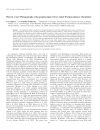| Nálezy podle období | |||||
|---|---|---|---|---|---|
| Chernetidae | 0-1900 | 1901-1950 | 1951-2000 | 2001+ | ∑ |
| Chernes hahnii (C. L. Koch, 1839) | 3× | 3× | |||
Chernes hahnii (C. L. Koch, 1839)
| České jméno | štírek parkový |
|---|---|
| Nálezy | 3 nálezů, 3 kvadrátů |
| Poslední nález | 2015 , Ondřej Machač |
| Fytogeografická oblast | - |
| Původnost stanovišť | - |
| Vlhkost stanovišť | - |
| Stratum | - |
| Osvětlení stanovišť | - |
| Hojnost výskytu |
|
| Nadm. výška | 150-300 |
Literatura
Dispersal capabilities do not parallel ecology and cryptic speciation in European Cheliferidae pseudoscorpions (Pseudoscorpiones: Cheliferidae)
The ability to disperse has continually shaped both the distribution and diversification of biota, and it affects the survival of the species with respect to wide-ranging habitat loss. As a response, organisms unable to spread by their own means often developed surrogate dispersal strategies. Pseudoscorpions possess small body sizes and cannot actively disperse over large distances and geographic barriers; therefore, they have adopted other ecological strategies. They are either sedentary and remain confined to stable environments or passively disperse via phoresy and are capable of inhabiting a wide variety of habitats, including temporary ones. In this paper, we use barcoding data to investigate the genetic diversity of four widely distributed and relatively morphologically uniform Cheliferidae genera Chelifer, Dactylochelifer, Rhacochelifer and Hysterochelifer. We aim to (i) test whether the genera harbor cryptic diversity and (ii) evaluate whether the genetic structure of the species parallels their dispersal capabilities and habitat preferences (i.e., ecological strategies). In general, we uncovered independent lineages within all analyzed genera, which indicates their need for a thorough and integrative taxonomic revision. More specifically, we detected a varying degree of genetic structuring among the lineages. Known phoretic species, as well as some species and delimited lineages that are not known to use this manner of dispersal, showed a complete lack of geographical structure and shared haplotypes over large distances, while other taxa had restricted distributions. We argue that genetic structure can be used as a proxy to evaluate species’ dispersal manner and efficacy. Our results also suggest that taxa inhabiting stable environments might use phoresy for their dispersal.
Phoretic or not? Phylogeography of the pseudoscorpion Chernes hahnii (Pseudoscorpiones: Chernetidae).
An organism’s ability to respond to ecological changes at its currently inhabited location, and to colonize a new one, is particularly important for organisms inhabiting ephemeral habitats. Phoresy, which involves attaching of a nonvagile individual to a selected carrier of a different species, is used by a wide variety of taxa, but surprisingly little is known about the genetic structure of phoretic species. A better understanding of their genetic structure would help elucidate the efficacy of this manner of dispersal. In this study, we analyse the phylogeographic patterns of the pseudoscorpion Chernes hahnii (C.L. Koch, 1839) across a 1830 km range, encompassing most of the species’ distribution range in Europe. The lack of geographic structure and low divergences within the two main clades suggest that Chernes hahnii disperses by phoresy. Individuals shared haplotypes at localities 350 km apart and very little divergence was detected between localities over 1450 km away from each other, indicating that phoresy is a very efficient manner of dispersal in this species. We also detected highly divergent populations within Chernes hahnii; however, more material and additional data would be necessary in order to evaluate the potential existence of cryptic diversity within this species.
Štírci (Arachnida: Pseudoscorpiones) CHKO Litovelské Pomoraví.
Faunistic data for pseudoscorpions from Litovelské Pomoraví PLA is given for the fi rst time. A total of 710 specimens of pseudoscorpions have been collected during the years 1998–2008 in this area. This material contains 11 species, representing 4 families. The most abundant were epigean species from the genus Neobisium which form 77,5 % of collected material. The concrete faunistic record of Mesochelifer ressli is presented from Czech Republic for the second time. A comparison with the other studied areas from the Czech Republic is presented.Statistiky
Dle měsíce v roce
Dle nadmořské výšky
Dle metody sběru (3 použitých nálezů)
| Chernes hahnii (C. L. Koch, 1839) | Samci | Samice | Mláďata | Nálezy |
|---|---|---|---|---|
| Individuální sběr | 1 | 0 | 0 | 1 |
| Prosev | 0 | 1 | 1 | 2 |
| Samci | Samice | Mláďata | Nálezy |
Dle biotopu (3 použitých nálezů)
| Chernes hahnii (C. L. Koch, 1839) | Samci | Samice | Mláďata | Nálezy |
|---|---|---|---|---|
| Slaniska | 1 | 0 | 0 | 1 |
| Lužní lesy nížin | 0 | 0 | 1 | 1 |
| Haldy a výsypky | 0 | 1 | 0 | 1 |
| Samci | Samice | Mláďata | Nálezy |





